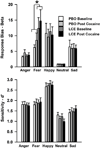Effects of levodopa-carbidopa-entacapone and smoked cocaine on facial affect recognition in cocaine smokers
- PMID: 26921145
- PMCID: PMC4794345
- DOI: 10.1177/0269881115626308
Effects of levodopa-carbidopa-entacapone and smoked cocaine on facial affect recognition in cocaine smokers
Abstract
In addition to difficulties in daily social functioning, regular cocaine users have decrements in social processing (the cognitive and affective processes underlying social behavior) relative to non-users. Little is known, however, about the effects of clinically-relevant pharmacological agents, such as cocaine and potential treatment medications, on social processing in cocaine users. Such drug effects could potentially alleviate or compound baseline social processing decrements in cocaine abusers. Here, we assessed the individual and combined effects of smoked cocaine and a potential treatment medication, levodopa-carbidopa-entacapone (LCE), on facial emotion recognition in cocaine smokers. Healthy non-treatment-seeking cocaine smokers (N = 14; two female) completed this 11-day inpatient within-subjects study. Participants received LCE (titrated to 400mg/100mg/200mg b.i.d.) for five days with the remaining time on placebo. The order of medication administration was counterbalanced. Facial emotion recognition was measured twice during target LCE dosing and twice on placebo: once without cocaine and once after repeated cocaine doses. LCE increased the response threshold for identification of facial fear, biasing responses away from fear identification. Cocaine had no effect on facial emotion recognition. Results highlight the possibility for candidate pharmacotherapies to have unintended impacts on social processing in cocaine users, potentially exacerbating already existing difficulties in this population.
Keywords: Facial emotion recognition; cocaine; dopamine; levodopa; social processing.
© The Author(s) 2016.
Conflict of interest statement
COI: The authors have no other conflicts of interest to declare.
Figures


Similar articles
-
Factors determining when to start levodopa/carbidopa/entacapone treatment in Spanish patients with Parkinson's disease.Neurologia. 2014 Apr;29(3):153-60. doi: 10.1016/j.nrl.2012.12.008. Epub 2013 Mar 5. Neurologia. 2014. PMID: 23465686 English, Spanish.
-
Double-blind trial of levodopa/carbidopa/entacapone versus levodopa/carbidopa in early Parkinson's disease.Mov Disord. 2009 Mar 15;24(4):541-50. doi: 10.1002/mds.22343. Mov Disord. 2009. PMID: 19058133 Clinical Trial.
-
Initiating levodopa/carbidopa therapy with and without entacapone in early Parkinson disease: the STRIDE-PD study.Ann Neurol. 2010 Jul;68(1):18-27. doi: 10.1002/ana.22060. Ann Neurol. 2010. PMID: 20582993 Clinical Trial.
-
Pharmacokinetic considerations for the use of levodopa in the treatment of Parkinson disease: focus on levodopa/carbidopa/entacapone for treatment of levodopa-associated motor complications.Clin Neuropharmacol. 2013 May-Jun;36(3):84-91. doi: 10.1097/WNF.0b013e31828f3385. Clin Neuropharmacol. 2013. PMID: 23673910 Review.
-
Optimizing levodopa therapy to treat wearing-off symptoms in Parkinson's disease: focus on levodopa/carbidopa/entacapone.Expert Rev Neurother. 2012 Feb;12(2):119-31. doi: 10.1586/ern.11.203. Expert Rev Neurother. 2012. PMID: 22288667 Review.
References
-
- APA. DSM-IV: Diagnostic and Statistical Manual of Mental Disorders. MD, US: American Psychiatric Association; 1994.
-
- Attwood AS, Penton-Voak IS, Goodwin C, Munafo MR. Effects of acute nicotine and alcohol on the rating of attractiveness in social smokers and alcohol drinkers. Drug Alcohol Depend. 2012;125:43–48. - PubMed
Publication types
MeSH terms
Substances
Grants and funding
LinkOut - more resources
Full Text Sources
Other Literature Sources
Medical

